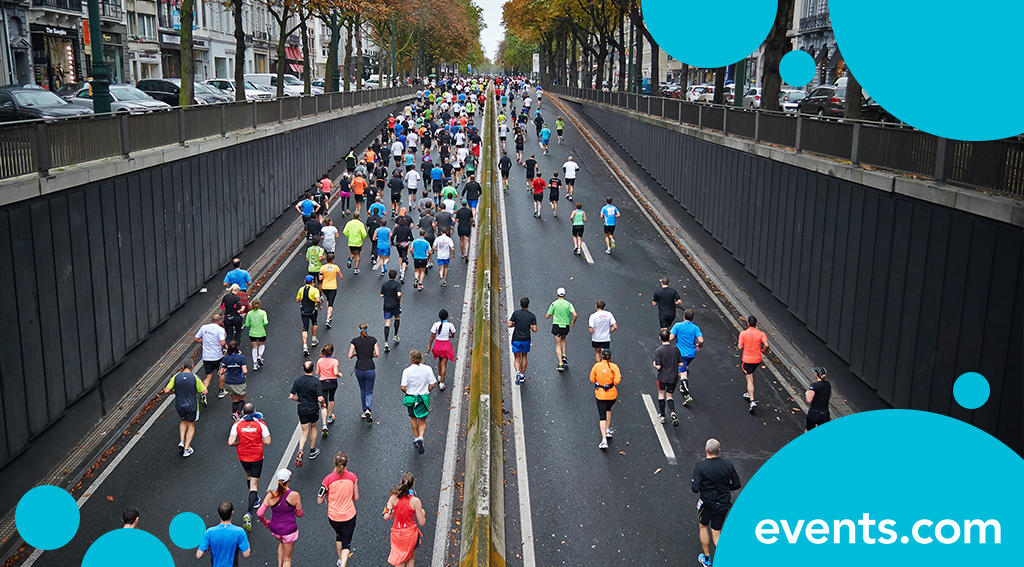Races happen around the world and accommodate diverse cultures, distances, fitness levels, and sporting disciplines. There are several types of races, including short sprints, marathon distances, trail running, and obstacle course races.
Each type of race has its own set of rules and objectives that will need to be identified and considered when planning for a running event. As the event planner, it’s up to you to decide whether your target audience is seasoned runners or novice runners, which type of running races you want to engage in, and how to plan for them.
Road Races: Long and Middle Distances
Road races are a popular type of running event that consists of both long and middle-distance races. They require a lot of planning and preparation, often months in advance, and include:
- Choosing a theme: While your running event doesn’t necessarily need a theme, choosing to bring a theme to your event can be a great way to improve the experience of your participants and attract a wider audience who may feel drawn to your theme, as it may be relevant to their interests.
- Picking the date & location: Choosing the date and location of your upcoming race event can make or break it. You’ll want to ensure that your race doesn’t coincide with important holidays or other events. Also, consider the weather. As for the location, choose one that your participants will be able to easily find and access. Cities are great places to host longer races as they will provide you with ample space.
- Selecting an objective: Objectives will give participants a reason to show up. Are there prizes involved? Is your event backing an important cause? Setting clear objectives for your race not only incentivizes participation but also adds purpose and significance to the event.
- Obtaining permits: Depending on your race’s type and location, there are bound to be permits that you’ll need to acquire. The requirements vary, so be sure to check with your city’s officials for the most up-to-date regulations.
- Hiring a team: As with any event, hiring a knowledgeable and skilled team is essential. You’ll need people dedicated to marketing and advertising, as well as those who can manage aide stations where participants can take a break or grab refreshments.
Road races are often divided into the following different types of running races:
5K Races
5K races are long-distance races. If you’re wondering how many miles a 5K race is, they span 3.1 miles or 5,000 meters. Not only do 5K races provide a chance for individuals to challenge themselves physically and mentally, but they also serve as a powerful platform for raising awareness and funds for charitable causes. Many 5K races are organized specifically to support various nonprofits for individuals looking to make a positive impact on their communities or support causes close to their hearts.
3K Races
3K races are similar to 5K races, except participants will run 1.86 miles or 3,000 meters instead. These shorter races are great for beginners in both racing and organizing, as they tend to be a lot less stressful when planning and competing. 3K races are also great for families with young children who want to participate and for those looking for a less intense and more relaxed experience.
Typical Marathons
Marathons are popular races but typically aren’t beginner friendly, as they span just over 42 kilometers or 26.2 miles. These races are mostly held on roads, but a few have been held on trails as well. Marathons are accessible and offer wheelchair divisions, allowing people of all abilities to participate.
Since marathons are long-distance races, it’s a good idea to set up portable restrooms, hand-washing areas, and aid stations along your chosen route.
Ultra-Marathons
Ultra-marathons are another type of marathon and are longer than the typical one. However, there’s no set distance for them, and they are usually described as being any footrace distance longer than a typical marathon. Extreme runners and those with higher experience levels will benefit the most from ultra-marathons.
Since ultra-marathons are so long, it’s wise to take your time when choosing your perfect route. Your participants will already be running more than the 26 miles in a typical marathon, so make sure that you help them out by providing them with a smooth, downhill terrain.
Trail Races
Trail races are races that include parts of road racing and hiking, allowing participants to run through nature and enjoy the natural beauty around them. Because these races happen on trails or other natural areas such as deserts and wooded areas, there is usually rugged terrain involved, including rocks, sand, mud, and grass. For that reason, these races are considered to be more challenging and require more preparation and safety measures.
In preparation, make sure that you are thinking about your participants and the enjoyment they will receive out of the race. Choose a trail that isn’t too difficult to ensure accessibility and fun.
Cross Country Races
Cross-country races consist of running between 2 and 6.2 miles and are usually held on fields, the countryside, wooded areas, and other natural terrain. These races provide a unique and challenging experience for participants, as they must navigate varying landscapes, conquer uneven terrain, and adapt to changing weather patterns.
Again, make sure you have the proper permits and protocols in place before starting your cross-country race. Ensure that your participants can familiarize themselves with the route to avoid getting lost along the way. In addition, provide ample stations for refreshments and aid in case participants need to rest.
Obstacle Races
Obstacle races blend cardio and strength training with running. As the name implies, participants compete in racers with obstacles that are strategically placed throughout. Obstacle races vary between running and climbing competitions and can happen on varying landscapes. The goal is to overcome them as quickly as possible.
To prepare, consider the type of obstacles you want to incorporate into your race and be sure to obtain the proper permits. Popular choices for obstacles include rope and wall climbing, walking on beams, climbing stairs, running through mud pits, and jumping through tires.
Color Runs
Color runs are a fun race stretching over five kilometers or 3.1 miles. They’re aptly named because, during each kilometer mark, participants, who are dressed in white at the beginning, receive colored powder poured on them. Participants then reach the end covered in different colors.
When planning your color run, make sure that you have enough colored powder to distribute amongst participants and that each kilometer mark is set up with a different powder.
Night Runs
Night runs happen during the night hours and are a great way for participants to unwind. Night runs also have more benefits, such as helping individuals run more consistently and improving sleep quality. However, without the proper safety measures, night runs can be dangerous.
As you prepare for a night run event, be sure to include extra safety measures like lights and safety vests. You may also want to consider where the event takes place. For example, roads can be dangerous at night as visibility is limited, so plan accordingly.
Virtual Races
Virtual races are flexible racing events and allow more individuals to participate no matter where in the world they are. There is no set location or style — participants can join in from any location of their choosing and can go at their own pace. In fact, participants don’t even have to leave their homes to compete. They can walk around their homes or use home-based treadmills. Results are measured, usually by an app on a phone, and medals are shipped directly to winners.
Virtual races rely a lot on digital marketing, so make sure to hire some people to take care of your marketing efforts. Since these races happen virtually, you’ll also want to make sure you choose the best check-in app for the job to offer both you and your participants a seamless experience.
Relay Races
Relay races are a cooperative style race where participants team up to compete in and finish races. Individuals start with a baton, run a specific distance, and then pass a baton onto the next runner, who continues on. Teams usually consist of four runners.
In setting up a relay race, make sure you set up your teams and mark the start and finish points as well as the halfway points where the batons will be traded off.
Sprint Races
Sprint races are one of the oldest running race types and occur over a shorter distance, typically spanning around 150 meters or 164 yards. They’re accessible, allowing most people to participate in them.
When organizing your sprint race, keep it simple. Consider the location, objectives, and market to bring in your audience. Since sprint races are short races and are meant to be a leisure activity, be sure to choose a fitting terrain, such as a smooth road or an indoor arena.
Plan Your Next Successful Running Race With an Event Planning Software
Planning a running event can be stressful, as there are many nuances that go into organizing a successful race. However, you can automate a lot of the manual tasks by using good event management software. Events.com Sell allows you to set up an event in minutes and takes care of everything from selling tickets to registration, building custom landing pages, viewing data and analytics, and more. With a simple fee structure, easy onboarding, 24/7 support, and the latest in event technology, you’ll find that organizing your event becomes a seamless and enjoyable process from start to finish.Â
Let us help you create your dream event today.






